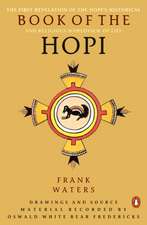Uses of Plants by the Hidatsas of the Northern Plains
Autor Gilbert L. Wilson Editat de Michael Scullinen Limba Engleză Hardback – iul 2014
From courtship rituals that took place while gathering Juneberries, to descriptions of how the women kept young boys from stealing wild plums as they prepared them for use, to recipes for preparing and cooking local plants, Uses of Plants by the Hidatsas of the Northern Plains provides valuable details of Hidatsa daily life during the nineteenth century.
Preț: 457.94 lei
Preț vechi: 538.74 lei
-15% Nou
Puncte Express: 687
Preț estimativ în valută:
87.62€ • 91.49$ • 72.52£
87.62€ • 91.49$ • 72.52£
Carte tipărită la comandă
Livrare economică 05-19 aprilie
Preluare comenzi: 021 569.72.76
Specificații
ISBN-13: 9780803246744
ISBN-10: 0803246749
Pagini: 476
Ilustrații: 71 figures, 1 map
Dimensiuni: 152 x 229 x 38 mm
Greutate: 0.84 kg
Editura: Nebraska
Colecția University of Nebraska Press
Locul publicării:United States
ISBN-10: 0803246749
Pagini: 476
Ilustrații: 71 figures, 1 map
Dimensiuni: 152 x 229 x 38 mm
Greutate: 0.84 kg
Editura: Nebraska
Colecția University of Nebraska Press
Locul publicării:United States
Notă biografică
Gilbert L. Wilson (1869–1930) was a well-known anthropologist whose dissertation on Hidatsa agriculture was published in 1917 and is still available in print today.
Michael Scullin is a codirector of Midwest Ethnohorticulture LLC. His articles have appeared in the journal Plains Anthropologist and in many edited volumes.
Cuprins
List of Illustrations
Preface
Acknowledgments
Introduction
Editor’s Note
Abbreviations: BBW=Buffalobird-woman; PW=Poor Wolf; GB=Goodbird; SW=Sioux Woman; GLW=Gilbert Wilson; WC=Wolf Chief; MS=Michael Scullin
1. Plants That Are Eaten
Domesticated plants (MS)
Sunflowers (BBW)
Corn-smut (BBW)
Prairie turnips (BBW)
Jerusalem artichokes (BBW)
Hogpeanut (BBW, WC, GB)
Chokecherries (BBW)
Making stone hammers (BBW)
Buffaloberries (BBW)
Gooseberries (BBW)
Black currants (BBW)
Wild grapes (BBW)
2. Plants That Can Be Eaten
Hawthorns (BBW)
Wild white onions (BBW)
Ball cactus (BBW, WC)
3. Plants That Are Sweet
Juneberries (BBW)
White juneberries (BBW)
Wild plums (BBW)
Strawberries (BBW)
Roses (BBW)
Red raspberries (BBW, SW, GB)
Biscuitroot (BBW)
Nannyberries (BBW)
Purple prairie clover (BBW)
4. Plants That Are Good to Chew
Sticky gum (BBW)
Pine pitch (BBW)
5. Plants That Smell Good
Purple meadow-rue (BBW)
Blue giant hyssop (BBW)
Sweetgrass (BBW)
Wild bergamot (BBW)
Pine needles (BBW)
Perfumes used in beds (BBW)
Beaver musk (BBW)
6. Plants That Have Medicinal Uses
Big medicine (BBW)
White and red baneberry (BBW)
Gumweed (WC)
Purple coneflower (WC)
“Medicine in the woods” (BBW)
Poison ivy (BBW)
Unknown grass (BBW, GB)
Peppermint (BBW)
7. Plants Used for Fiber
Dogbane (WC)
Upright sedge (BBW)
Grasswork ornaments on leggings (Isokikuas)
8. Plants Used for Smoking
Tobacco 9a (BBW)
Tobacco 9b (WC)
Red-osier dogwood (BBW)
Bearberry (BBW)
Bearberry or kinnikinnick (WC)
9. Plants Used for Dye and Coloring
Yellow owl’s-clover (BBW)
Water smartweed (BBW)
Dye plants—unidentified (BBW)
10. Plants Used for Toys
Umakixeke, or game of throwing sticks (BBW, GB)
Popguns (BBW)
A toy horse
Reed whistle (GB)
11. Plants Used for Utilitarian Purposes
Cordgrass (BBW)
Buckbrush (BBW)
Cattails (BBW)
Box elder (BBW)
Buffalograss (BBW)
Big bluestem (WC)
Common rush (BBW)
Scouringrush horsetail (WC)
Puffball (BBW)
Snakewood (BBW, WC)
Goldenrod (BBW)
Prairie grasses as fodder (WC)
12. Plants Used for Rituals or with Ritual Significance
The three kinds of sage (WC)
Pasture sage 1 (BBW, GB)
Pasture sage 2 (BBW, WC)
Common sagewort (BBW, WC, GB)
Black sage (BBW, WC)
Fringed sage (PW)
Juniper (Cedar) (BBW, WC, GB)
Creeping juniper (BBW, GB)
Prairie sandreed (WC)
Bittersweet (WC)
13. Sources of Wood
Wood as a resource (MS)
Cottonwood (WC)
Ash (BBW)
Peachleaf willow (BBW)
Sandbar willow (BBW, WC, GB)
Heart-leaved willow (BBW)
Quaking aspen (BBW)
American elm (BBW)
Water birch (BBW)
Box elder (BBW)
14. Uses of Wood
Gathering firewood (WC)
Digging-sticks (BBW, WC)
Mortar and pestle (BBW)
Making a bullboat frame (BBW)
Making a wooden bowl (WC)
Rakes (and the bison scapula hoe) (BBW, WC)
Paddle for working clay pots (cottonwood bark) (GLW)
15. Arrows
Significance and utility (MS)
Making arrows (WC)
Types of arrows (WC)
Bows (WC)
Arrows for boys (BBW, GB)
Mock battle with grass arrows (WC)
16. Earthlodges
Building an earthlodge (BBW)
On earthlodges (The observations of Hairy Coat and Not A Woman)
Winter lodges and twin lodges (BBW)
The peaked or tipi-shaped hunting lodge (BBW)
The use of sod as an earthlodge covering
Dismantling an old earthlodge (BBW)
Like-a-Fishhook Village and environs (WC)
17. Miscellaneous Material
Basket making (BBW)
Native drinks of the Hidatsas (BBW)
How our meals were served (GB)
Nettles (BBW)
Forest fire (GLW)
Conclusion
Appendix: Frederick N. Wilson’s Comments on “The Hidatsa Earthlodge”
Bibliography
Recenzii
"[Uses of Plants by the Hidatsas of the Northern Plains is] indispensable to anyone interested in Native American life on the plains; valuable for ethnobiology and Native American studies."—E. N. Anderson, CHOICE
"Use of Plants by the Hidatsa is an easy, enjoyable read and a unique, valuable source of information on how people used plants."—Midcontinental Journal of Archaeology
“Every aspect of life is part of this classic ethnology, from acquisition of food to spirituality to the raising of the four sacred wooden pillars of a new Earth Lodge. . . . Editor Michael Scullin does a wonderful job of weaving the many living parts of Buffalobird-woman’s story. . . . The book’s precision—many specific uses for many plants—is a pleasure to read. One gets a sense of a people who rose to the challenge of using what nature provided them to wrest a living from a demanding environment.”—Bruce Johansen, Jacob J. Isaacson Professor of Communication and Native American Studies at the University of Nebraska at Omaha and author of The Native Peoples of North America: A History












